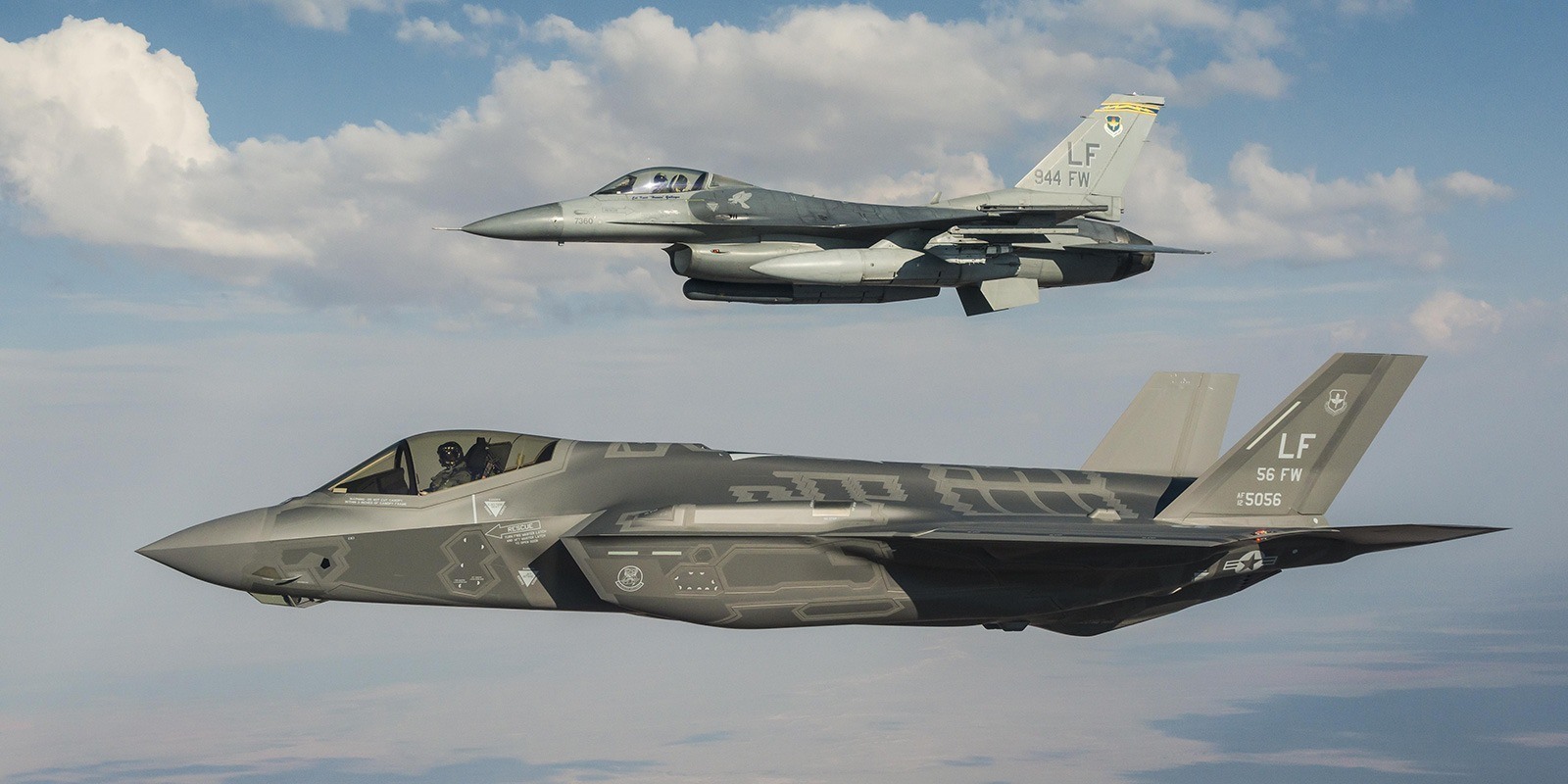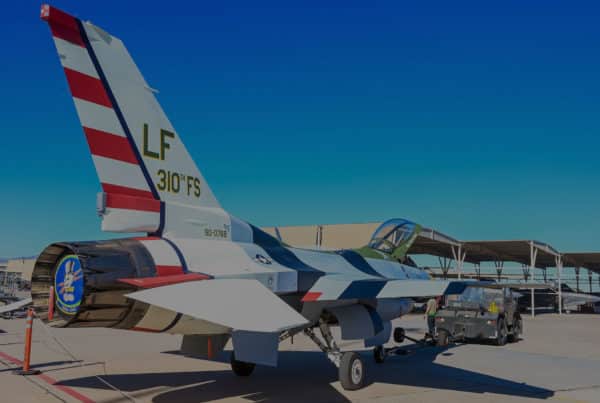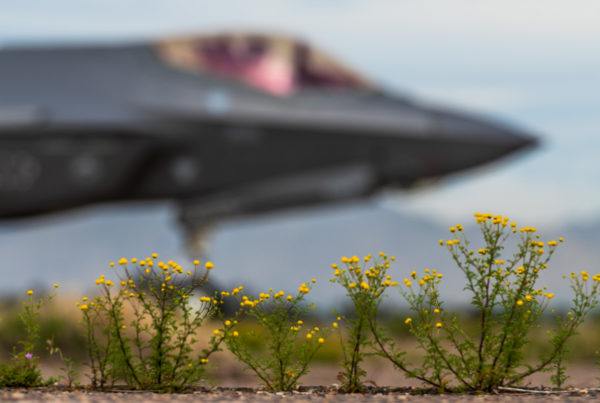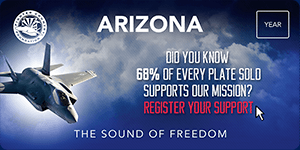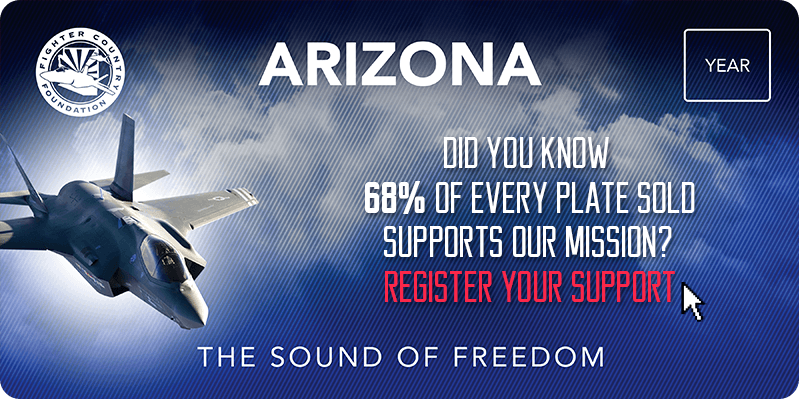
BRIG. GEN. JERRY D. HARRIS points out various patches in his office Aug. 30 at Luke Air Force Base. Many of the patches bear his current call sign, “Luke 1,” which he will hand over to Brig. Gen Michael Rothstein Sept. 12 when he leaves for Yokota Air Base in Tokyo where he will be the vice commander.
Brig. Gen. Jerry D. Harris’ term as commander of Luke Air Force Base can easily be described as historic. Just weeks ago, the installation was chosen to train the F-35 fighter jet, in essence ensuring its presence for decades to come.
While the decision was made by people a lot higher up than Harris, he can always say he was the leader at the time.
Next week, he will hand over the reins of the Glendale base, which changes commanders every two years.
Harris will go on to be the vice commander of Fifth Air Force, a tenant unit at Yokota Air Base in Tokyo, and Brig. Gen. Michael Rothstein will come from the 35th Fighter Wing, Misawa Air Base in Japan to take his place.
While Harris is leaving the country for his next assignment, he plans to return to the Valley, because his wife is an Arizona native and they have a home in Waddell.
The West Valley View recently sat down with him to take a look back at his time at Luke.
WVV: Did you train at Luke as a student pilot?
Harris: I did. I was at Willie (Williams Air Force Base) back in 1986, and then I’ve been through Luke a couple of times getting training as a student, and I was here as an instructor in ’92 and ’93.
WVV: What was it like coming back as the wing commander?
Harris: I understood the mission, but I didn’t know the size and the scope of it. We train half of the Air Force’s fighter pilots right here, and that’s a huge impact.
It’s a fantastic community, as you would expect, with a lot of the Tom Cruise-type leaders, people that are very energetic and outgoing. Bringing them into one flow and one direction is not easy to do.
I just know the impacts we have flow across the Air Force, so that was something I had to get my arms around.
WVV: As a wing commander, what are some of your main duties on a daily basis?
Harris: Well, I have to participate in the mission, so I fly two or three times a week and a flight is an eight-hour event. We’re only airborne for a 90-minute period, but two hours before, we start our briefing and then we walk out to the airplane an hour prior. After it lands, we shut it down and work with maintenance to get it fixed for the next sortie.
Then working with the student the day prior and debriefing them after to let them know their performance and show them where they can do better and what they did right.
Back in 1941 when Luke Field started, we’ve got some facilities that are about that old. So keeping up with those and working with the support teams to make sure the infrastructure is good for the next 30 or 40 years is a big part of our time.
Then just people management and leadership. We have a lot of young airmen not getting much money for what they’re doing. They’re getting enough, but to get somebody motivated to do their job when it’s 115 degrees and they’re out in the sun doing that, and to have a smile on their face, that takes a lot of effort.
That’s the fun part; it’s very rewarding to see how professional they are, whether they’re turning a wrench on the flight line or guarding the gate or part of the explosive ordnance disposal team or a fireman, it’s just a great group of people.
WVV: When you first arrived at Luke, what were some of your main goals for the base, and do you think you’ve accomplished those?
Harris: Initial goals were to continue the mission and be more efficient with that. The mission at Luke is pretty simple: Graduate the world’s best F-16 pilots and greatest crew chiefs and maintainers and then deploy combat-ready airmen. I tried to enhance each one of those and make them a little better.
We’re graduating more pilots now than before. We went over our 10,000th crew chief in July of last year, so we’re doing well in that area and continue to make them better crew chiefs. Then last year we deployed over 500 airmen into the fight in Afghanistan and Iraq.
Then I had some personal things we tried to work through with the base. We’re airmen 24/7, and one of the things that were important to me when I got here is that we had a lot of DUIs and a lot of negative things that we just don’t need in a professional organization.
I understand the need when people are working as hard as we are to be able to relax, let their hair down and make sure they’re able to come back to work fully energized, but we were making some basic mistakes and not taking care of each other.
We went from one to two DUIs a week to one to two a month, and that’s a significant improvement. Now, zero is the goal, but we’ll never get there. Certainly, helping the community and being better partners is part of that.
WVV: There’s been such a build-up about the F-35s for the last few years. Are you disappointed to be leaving Luke before they arrive?
Harris: No, first off I’m ecstatic that Luke was selected for the F-35. Part of it is the installation and what we offer for a base, but a big part is the community.
We have such a supportive community and I’m the envy of a lot of the wing commanders because everybody here is so positive.
We’re putting on contract nearly $200 million in construction and upgrades and renovations, so we’ll see jobs, contractors and a lot of people start to flow through the base.
I’m not disappointed I’m going to miss that. That’s a dusty, dirty climate with road closures and all the things associated with it. So I get to leave with the success piece that we were selected.
WVV: Did you play any part in the F-35 selection process?
Harris: It was at all levels, so even our youngest airmen were interviewed on the impacts and how would this facility work and what would change on the flight line?
From our senior Air Force leadership down to our newest recruit, everybody was involved.
WVV: What impact do you think the F-35 will have on the base and the surrounding communities?
Harris: I hope for little impact. You’ll see a positive impact with new construction and things associated with that.
The airplane, compared to an F-16, is a little noisier, but we’re working on ways to mitigate and reduce that noise.
It’s so hot in Arizona that the F-16 with the smaller engine that it has actually had to do an afterburner take-off more than half the time. The F-35 won’t.
It’s a much more powerful engine that can do a military take-off and only do an afterburner take-off for training a couple of times for each student.
A military take-off is like pushing your car accelerator fully to the floor to go. The afterburner is dumping raw gas into that, so it’s like firing up the turbocharger, which is even noisier.
We won’t have to do that as often, so the F-35 may actually be the same or a little quieter than the F-16 on the given take-off to take-off. Then, flying around the Arizona community, it flies much like the F-16.
WVV: I understand an F-35 was here a few weeks ago. Did you get a chance to check it out?
Harris: I went out and looked at it. It was actually an F-35B model, which is a Marine variant, and it was flying from the Texas plant where they’re built to Edwards Air Force Base for testing.
It had an emergency, and we were the nearest place to land. It sat here for a week or two, a team came out and fixed the airplane and it took off.
Funny, we had zero complaints. We weren’t hiding the fact that we had an F-35 here, but I was just curious if we didn’t tell anybody if they would notice the noise of taking off. Not a thing.
A week later we had some F-15s here taking off and we had several people call and say, “Hey, the F-35 is here; I can hear it. They’re louder.”
WVV: What is your most memorable flying experience?
Harris: Flying with young lieutenants; somebody with eight or nine hours in the airplane.
The first time you get back in it with an old guy like me and a lieutenant that’s probably 22 or 23 years old with a year and a half of flying experience but only eight or nine hours flying the airplane, it’s eye-opening.
We have to make sure we teach the basics because you give them a task to do and they’re going to do that task. Some of them will forget they’re flying an airplane while doing that task and their head is down.
So we’re always watching them and that’s part of our process. We recognize that there’s going to be those errors and that’s why we have instructors.
WVV: What was your call sign before you became a commander?
Harris: J.D. I’m lucky it’s my initials, but that isn’t actually how I earned that call sign.
WVV: So what’s that story?
Harris: I may have had a little too much Jack Daniels to drink one time, and that stuck with me. It’s a great experience for me to look back and remember that event and say, “I don’t need to do that again.” I was a young lieutenant once.
WVV: Any advice for the incoming commander?
Harris: Have fun. We select our commanders knowing they’re going to succeed in what they do. It’s not a test.
When I pick squadron and group commanders to come here and work, I know they’re going to succeed in what they do. I just watch how they succeed.
Anybody can row a boat across the English Channel and get to the other side and storm the beach. The commanders that really succeed well are those who have somebody else in the boat. The commander going alone isn’t going to win that fight.
How they do that job and how they motivate the people around them, that’s what’s important. It’s teamwork to get the military to be successful in our mission. So if the commander is having fun, they’re probably doing it the right way.
WVV: Is there anything else you’d like to add?
Harris: It’s been nice to be home, but as we say in the Air Force, it’s time to move on. I’m looking forward to other challenges and being in Japan and Yokota. I haven’t been stationed there before, so that’s a new challenge for us.
I’m also looking forward to coming home here in a few years and being an Arizona resident again and putting our roots down and being on the other side of the fence as a retiree.
By Emily McCann, Staff writer – West Valley View

